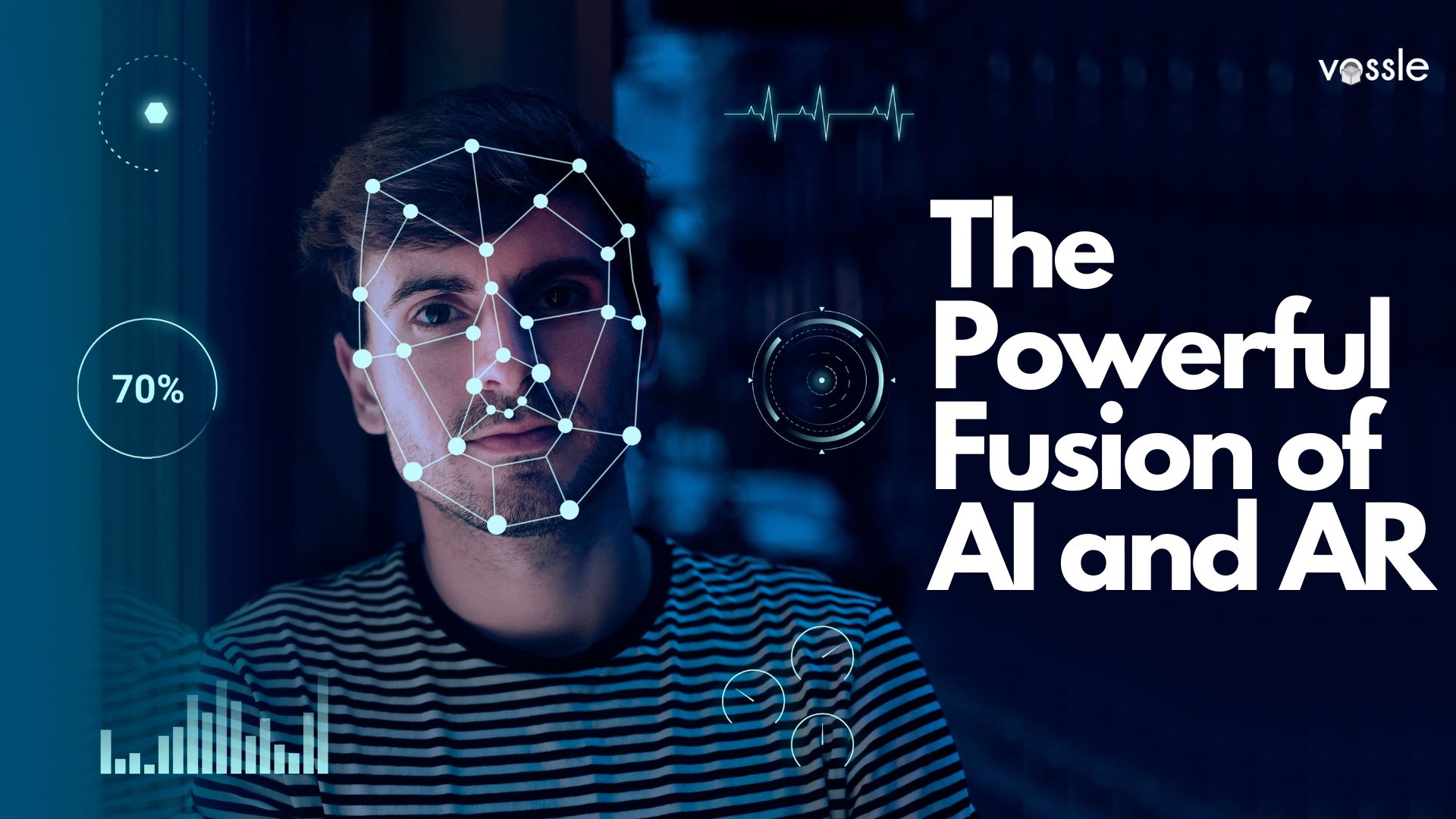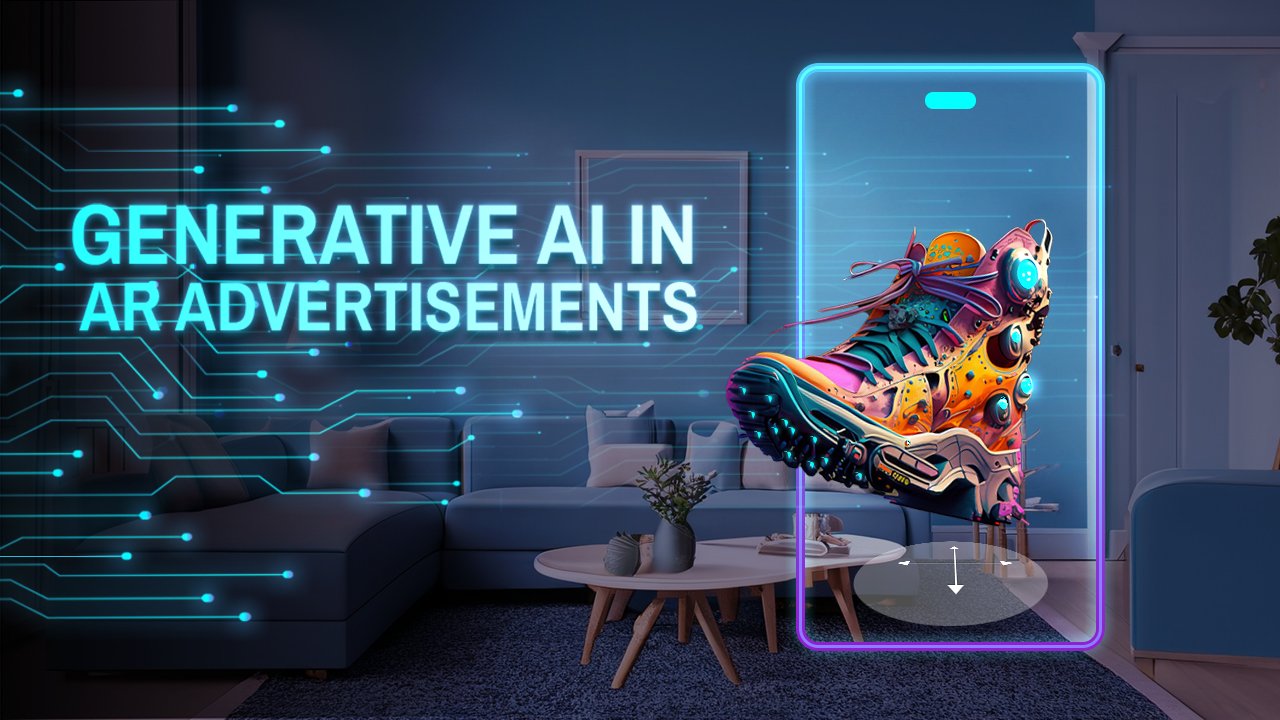Ever imagined a world where technology seamlessly integrates with our reality? A world with enhanced digital experiences is hard to separate from reality? Well, this world is no longer imaginary, the powerful fusion of Artificial Intelligence (AI) and Augmented Reality (AR) is making it possible.
AI, the ability of machines to simulate human intelligence, and AR, the technology that overlays digital content in the real world, are joining forces to create next-level experiences that are reshaping various industries.
In this blog, we will explore the amazing technology that AI and AR are, highlight their growing impact on our world, and delve into how their combined potential is revolutionizing the way we interact with technology.
Understanding AI: Unlocking Intelligent Capabilities

Before we dive into the incredible possibilities of AI and AR together, let’s first understand AI on its own.
Artificial Intelligence refers to the ability of computer systems to perform tasks that would typically require human intelligence. It encompasses various techniques such as machine learning, natural language processing, and computer vision.
AI has already found its way into our lives through the recent surge in its applications across sectors including Generative AI such as ChatGPT, and Dall-E, Smart assistants like Siri and Alexa, our favorite, recommendation algorithms on streaming platforms like Netflix, and even autonomous vehicles.
The true power of AI lies in its ability to learn from data, adapt to changing scenarios, and make intelligent decisions. It can analyze vast amounts of information, identify patterns, and provide valuable insights.
One fitting example would be AI-powered chatbots like ChatGPT can understand and respond to human queries, saving time and improving customer service in industries ranging from e-commerce to healthcare. The integration of AI into different sectors has already brought significant advancements and is reshaping the way we work and live.
Decoding AR: Enhancing Realities with Digital Overlays
Now, let’s turn our attention to Augmented Reality, an exciting technology that seamlessly blends the digital world with our physical surroundings. Augmented Reality overlays digital content, such as 3D models, animations, or information, onto the real world through devices like smartphones, tablets, or smart glasses.
AR enhances our perception of reality by adding virtual elements and enabling us to interact with them in real-time.
AR Capabilities
The capabilities of AR are truly astounding. See the example made on Vossle we shared below, it allows users to try out furniture in their living room before making a purchase. Thereby, helping them in better decision-making with the help of deeper insight into 3D models. Additionally, it improves their purchase intent and enhances brand loyalty through the unique way of product interaction.
It doesn’t stop there, AR is also helpful in multiple ways. AR can be used in visualizing complex data more immersively, or even let users experience historical events by bringing them to life right in front of their eyes. The possibilities are literally endless.
When it comes to transforming businesses, AR has already made significant strides in industries like gaming, retail, and education. The popular game Pokémon Go, which superimposes virtual creatures onto real-world environments, was a prime example of the impact and widespread adoption of AR.
When the fusion of AI and AR comes, their combined potential is revolutionary. AI’s intelligent capabilities combined with AR’s ability to enhance our realities create a potent combination that opens up limitless possibilities.
From personalized shopping experiences and immersive gaming to improved healthcare and transformative education, the integration of AI and AR is reshaping the way we experience and interact with technology.
In the next segments of this blog, we will further explore how AI enhances AR experiences and how AR enhances AI capabilities, delving into the specific applications and challenges presented by this exciting fusion. Stay tuned to uncover more about the exciting future of next-level experiences with AI and AR!
The Perfect Pair: Exploring the Synergy between AI and AR
The synergy between AI and AR is a remarkable fusion that has huge world-altering potential.
On one hand AI, with its intelligent algorithms, enhances AR experiences by providing real-time object recognition, natural language processing for seamless voice commands, and personalized adaptive content.
AR, on the other hand, enriches AI capabilities by visualizing AI-generated data and insights, enabling spatial mapping for enhanced data analysis, and improving human-computer interaction through immersive AR overlays.
Together, AI and AR create a powerful symbiotic relationship, revolutionizing the way we interact with technology and opening doors to next-level experiences that blend the virtual and physical worlds seamlessly.
AI-Driven Object Recognition: Enriching AR Experiences with Smart Insights
One of the key areas where AI enhances AR experiences is through object recognition. AI algorithms can analyze real-time visual data from the AR environment and identify objects with remarkable accuracy.
This capability enables AR applications to overlay contextual information, such as product details or user instructions, onto recognized objects.
For instance, imagine pointing your smartphone at a museum exhibit, and AI-powered AR instantly providing you with detailed historical information about the artifact. AI-driven object recognition enriches AR experiences by providing smart insights and enhancing our understanding of the world around us.
Personalization and Adaptation: Tailoring AR Content with AI Algorithms
Personalization is another area where AI and AR create a powerful synergy. AI algorithms can analyze user data and preferences to tailor AR content accordingly. This means that each user can have a customized AR experience based on their individual needs and interests.
For example, an AI-powered AR language learning application can adapt its content and difficulty level based on the user’s proficiency and learning pace.
The integration of AI algorithms enables AR to deliver highly personalized and adaptive experiences, making technology more relevant and engaging.
Immersive Storytelling: AI’s Contribution to Compelling AR Narratives
AR has the incredible ability to create interactive and immersive narratives. And with AI, this storytelling aspect gets enhanced even further.
With AI algorithms, AR applications can generate dynamic and context-aware narratives that respond to user inputs or environmental cues.
For example, users can go on to explore an AR-based mystery adventure where AI algorithms adapt the storyline based on their choices and interactions.
AI’s contribution to compelling AR narratives brings a new level of engagement and immersion, making the storytelling experience even more captivating.
Harnessing the Power of AI to Overcome Challenges in Augmented Reality
Augmented Reality (AR) technology has immense potential to transform how we experience the digital world. However, it also faces various challenges that need to be addressed for seamless user experiences.
Fortunately, the integration of Artificial Intelligence (AI) comes to the rescue, offering solutions to these hurdles.
In this segment, we will explore the challenges faced by AR and how AI helps overcome them, unlocking the true potential of this exciting technology.
Enhancing Object Recognition and Tracking:
A major challenge in AR is accurately recognizing and tracking objects in the real world. This is where AI shines. Through advanced computer vision techniques, deep learning algorithms, and neural networks, AI empowers AR systems to identify and track objects in real-time.
This breakthrough enhances the realism and immersion of AR experiences, making virtual elements seamlessly blend with the physical environment.
Enabling Natural and Intuitive Interactions:
Interacting with AR applications should be intuitive and effortless. AI’s natural language processing (NLP) capabilities enable AR systems to understand and interpret user commands.
With AI-powered NLP algorithms, users can control and manipulate AR elements using simple voice commands, making interactions feel more natural and user-friendly.
Personalization and Adaptive Experiences:
Tailoring AR content to individual users is crucial for a truly immersive experience. AI algorithms analyze user data, preferences, and behavior to deliver personalized AR content and recommendations.
By leveraging machine learning, AI enables AR systems to adapt to users’ needs and provide contextually relevant information and virtual objects. This personalization creates engaging and meaningful experiences that resonate with users on a deeper level.
Enhancing Human-Computer Interaction:
AR aims to bridge the gap between the digital and physical worlds. AI plays a significant role in enhancing human-computer interaction in AR environments. Gesture recognition, facial recognition, and emotion detection powered by AI enable users to interact with virtual elements using hand gestures or facial expressions.
These advancements create a more intuitive and immersive AR experience, making users feel connected and in control.
Harnessing the Power of Data:
AR generates vast amounts of data that can be leveraged for insights and improvements. AI algorithms excel at analyzing this data in real-time, extracting valuable information, and providing actionable insights.
By analyzing sensor data from AR devices, AI can detect patterns, trends, and anomalies, empowering users with valuable information and enhancing the functionality of AR applications.
The challenges faced by Augmented Reality are met head-on by the integration of Artificial Intelligence. From object recognition to natural interactions, personalization, enhanced human-computer interaction, and data analysis, AI empowers AR systems to deliver immersive, personalized, and data-driven experiences.
As AI continues to advance, we can expect even greater breakthroughs in overcoming the challenges of AR, unlocking the full potential of this groundbreaking technology. The fusion of AI and AR paves the way for a future where digital and physical realities seamlessly coexist, revolutionizing how we interact with the world around us.
In the next segment of this blog, we will explore the next-level experiences enabled by AI and AR in gaming, education, retail, and healthcare, showcasing the transformative power of this remarkable fusion. Stay tuned to discover the exciting possibilities that lie ahead!
Industry Applications: Transforming Education, Gaming, Retail, and More
The fusion of Artificial Intelligence (AI) and Augmented Reality (AR) has opened up a world of possibilities across various industries. In this segment, we will explore the transformative applications of AI and AR in education, gaming, retail, and healthcare.
From personalized AI tutors revolutionizing learning environments to immersive gaming experiences and AI-powered shopping assistants, the combination of AI and AR is reshaping how we interact with technology in these industries.
Additionally, in healthcare, AR-assisted surgeries and real-time AI analysis are enhancing precision and diagnostic capabilities. Let’s delve into these exciting industry applications and discover the ways AI and AR are revolutionizing our experiences and transforming these sectors.
Education and Training: Augmented Learning Environments with Personalized AI Tutors
The combination of AI and AR has the potential to revolutionize education and training. Augmented learning environments can provide students with immersive and interactive experiences, allowing them to visualize complex concepts and engage in hands-on learning.
AI-powered tutors can offer personalized guidance and feedback, adapting to individual learning styles and helping students achieve better educational outcomes. This integration has the power to transform traditional classrooms into dynamic, personalized learning spaces.
One of the most renowned examples is Google Skymap, a mobile application that allows users to explore and identify celestial objects in the night sky. Using Augmented Reality (AR) and Artificial Intelligence (AI), Google Sky Map uses your smartphone’s camera and sensors to overlay a real-time view of the stars, planets, and constellations on your device’s screen.
By utilizing AR technology, Google Sky Map superimposes digital information about the stars and other celestial bodies onto the live camera feed, creating an interactive and immersive stargazing experience.
As you move your device around, the AR technology tracks your orientation and adjusts the on-screen display accordingly, providing a dynamic and accurate representation of the night sky.
Moreover, AI algorithms within Google Sky Map analyze the captured imagery and match it with a vast database of astronomical information. This allows the app to identify and label celestial objects in real-time, providing users with valuable insights and knowledge about what they’re observing.
Whether you’re a casual stargazer or a passionate astronomer, Google Sky Map harnesses the power of AR and AI to make astronomy more accessible and engaging for everyone.
Gaming and Entertainment: Immersive Gaming Experiences with AI-Powered Characters and Objects
Gaming and entertainment industries have already witnessed the transformative potential of AI and AR. With AI algorithms powering intelligent characters and objects, gaming experiences become more realistic, adaptive, and engaging.
AI-driven behaviors enable characters to interact with players in dynamic ways, adjusting their responses based on the player’s actions and decisions. This integration also opens up possibilities for collaborative multiplayer experiences where virtual and real-world elements seamlessly merge, creating a whole new level of immersion and excitement.
An example of AR and AI used in entertainment would be Peridot. Peridot is an AR and AI-powered pet simulation game by Niantic. Players can nurture virtual creatures called Peridots, bonding with them through activities like playing fetch and teaching tricks.
With real-time mapping and AI technology, Peridots interact with the real world and become smarter over time. Available on mobile devices, Peridot aims to push the boundaries of AR gaming and inspire future experiences on AR hardware.
Retail and E-commerce: AI-Powered Virtual Shopping Assistants with AR Product Visualization
In the retail sector, AI and AR are revolutionizing the way we shop. AI-powered virtual shopping assistants provide personalized recommendations based on user preferences and buying history, enhancing the overall shopping experience.
AR product visualization allows customers to see how furniture, clothing, or other items would look in their homes or on themselves, eliminating guesswork and increasing purchase confidence.
The fusion of AI and AR empowers retailers to offer highly tailored and immersive shopping experiences, bridging the gap between online and in-store interactions.
An example of this would be IKEA Kreative. This innovative app seamlessly combines AI and AR technologies to revolutionize your home design process. By scanning your room, AI-powered algorithms intelligently remove existing items, while AR overlays virtual furniture options in real-time.
IKEA Kreativ immerses users in a world where AI enhances their spatial understanding, allowing them to visualize and experiment with different furniture arrangements.
Healthcare and Medicine: AR-Assisted Surgeries with Real-Time AI Analysis
The healthcare and medicine industry will benefit greatly from the synergy of AI and AR. AR-assisted surgeries provide surgeons with real-time guidance and insights through AR overlays, improving precision and reducing surgical risks.
AI algorithms can analyze medical images, detect anomalies, and provide diagnostic support, leading to faster and more accurate diagnoses. Integrating AI and AR in healthcare paves the way for personalized treatment plans, improved patient outcomes, and more efficient healthcare delivery.
Here is a study sourced from the National Library of Medicine that gives a glimpse of the transformative power that AI and AR hold. The synergy between these technologies has the potential to revolutionize various sectors, providing enhanced experiences, improved efficiency, and better outcomes.
As we move forward, the advancements in AI and AR will continue to unlock new possibilities, shaping the future of education, gaming, retail, healthcare, and many more industries. Exciting times lie ahead as we witness the full potential of AI and AR unfold.
The Future of AI + AR: Anticipating Next-Level Experiences
The integration of AI and AR has already paved the way for remarkable innovations, but the future holds even greater possibilities. Advancements in AI algorithms and machine learning techniques will enable more intelligent and context-aware AR experiences.
We can anticipate improved object recognition capabilities, enhanced natural language processing for seamless voice commands, and sophisticated algorithms that adapt and personalize AR content in real-time.
The fusion of AI and AR may also lead to the development of more advanced holographic displays and wearable devices, creating immersive experiences that blur the line between the physical and virtual worlds.
The impact of AI and AR on various industries is poised to be profound. In education, AI-powered personalized tutoring combined with AR learning environments will revolutionize how students acquire knowledge.
The gaming and entertainment industry will continue to thrive with more immersive and interactive experiences, where AI-powered characters and objects become indistinguishable from reality. Retail and e-commerce will see further transformation as AI-driven virtual shopping assistants and AR product visualization become mainstream, providing highly personalized and engaging shopping experiences.
In healthcare, the integration of AI and AR will lead to advancements in surgical procedures, diagnostics, and patient care, ultimately saving lives and improving overall well-being.
The combination of AI and AR offers a multitude of benefits and possibilities. It enhances our ability to interact with technology in more natural and intuitive ways, blurring the boundaries between the physical and digital realms.
AI-driven object recognition enriches AR experiences with smart insights, while personalization and adaptation tailors AR content to individual needs and preferences. Immersive storytelling becomes more captivating with AI’s contribution to compelling AR narratives.
Moreover, the integration of AI and AR addresses challenges in various industries, from education and gaming to retail and healthcare, leading to improved outcomes, increased efficiency, and enhanced user experiences.
Closing Thoughts: Exciting Future of Next-Level Experiences with AI and AR
As we embark on this journey into the future, the prospects of AI and AR integration are truly thrilling. The powerful fusion of these technologies is set to revolutionize the way we learn, play, shop, and receive healthcare.
Next-level experiences await us, where the virtual and physical worlds seamlessly merge, creating immersive and personalized encounters. While challenges such as ethical considerations, privacy concerns, and technical limitations must be addressed, the potential benefits and possibilities are immense.
We stand at the cusp of a new era, where AI and AR will shape our lives in ways we have yet to fully comprehend. Let us embrace this exciting future with open minds and a spirit of innovation, for the union of AI and AR holds the promise of extraordinary experiences that will enrich our lives and transform the world as we know it.



















